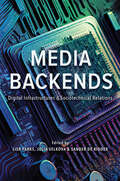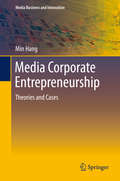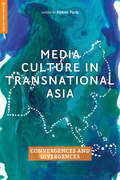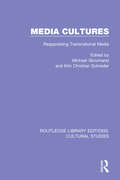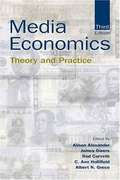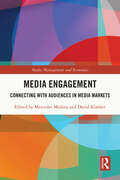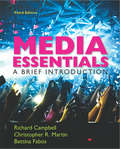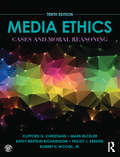- Table View
- List View
MedSource Technologies
by Robert S. HuckmanConsiders the issues facing Richard Effress, MedSource's chairman and CEO, as the firm approaches the Precision Cut project--the first test of MedSource's capabilities as an integrated, contract manufacturer in the medical device industry. MedSource Technologies was formed in 1999 by the simultaneous acquisitions of seven component manufacturing companies serving original equipment manufacturers in the medical device industry. The firm's model of integrated manufacturing aimed to leverage its expertise in manufacturing to become a single-source supplier of customized services in product design and development, rapid prototyping, component manufacturing, device assembly, and supply chain management.
MedVal Ventures
by Regina E. HerzlingerIs medical travel a viable business opportunity? A group of MBA students consider the pros and cons of starting a business that would send people from the U.S. to India for elective non-emergency surgeries.
Medalogix
by Matthew Preble Richard G. HamermeshThis case examines an exciting new approach to health care that will help care providers identify when hospice services are the appropriate type of care for patients. The company, Medalogix, already has a product on the market that uses a proprietery algorithm to consider dozens of factors and determine when a patient qualifies for a hospice care eligability review. The product has started to gain traction, and the case explores how Medalogix can scale and disseminate its innovative product.
Medell n Reborn (A)
by Ashish Nanda Margaret Cross Jorge TamayoIn 2003, mathematics professor Sergio Fajardo was elected mayor of Medell n, Colombia - one of the most violent cities in the world at that time. As mayor, Fajardo faced a host of daunting challenges. Rampant gang violence had raised Medell n's homicide rate dramatically, and a history of corruption had undermined the public's trust in the local government and law enforcement institutions. The under-resourced local police did not communicate clearly with the mayor, and the city was approaching bankruptcy. To address these concerns, Fajardo would need to not only develop a strategy, but also convince the majority of his 21-member city council - among whom he had only one ally - to support it. Fajardo needed to decide how to prioritize the many financial, legal, and cultural concerns in Medell n to bring the city closer to peace and prosperity.
Media Backends: Digital Infrastructures and Sociotechnical Relations (Geopolitics of Information)
by Jonathan Cohn Vicki Mayer Ranjit Singh Mark Andrejevic Lisa Parks Zala Volcic Amanda Lagerkvist Anne Kaun Tim Markham Kaarina Nikunen Stine Lomborg Rahul Mukherjee Vibodh Parthasarathi Philippe Bouquillion Jacek Smolicki Fredrik Stiernstedt Christine Ithurbide Faithe Day Sander De Ridder Fatima Gaw Alexis Logsdon Philipp Seuferling Matilda Tudor Julia VelkovaExploring how we make, distribute, and consume today’s media systems Media backends--the electronics, labor, and operations behind our screens--significantly influence our understanding of the sociotechnical relations, economies, and operations of media. Lisa Parks, Julia Velkova, and Sander De Ridder assemble essays that delve into the evolving politics of the media infrastructural landscape. Throughout, the contributors draw on feminist, queer, and intersectional criticism to engage with infrastructural and industrial issues. This focus reflects a concern about the systemic inequalities that emerge when tech companies and designers fail to address workplace discrimination and algorithmic violence and exclusions. Moving from smart phones to smart dust, the essayists examine topics like artificial intelligence, human-machine communication, and links between digital infrastructures and public service media alongside investigations into the algorithmic backends at Netflix and Spotify, Google’s hyperscale data centers, and video-on-demand services in India. A fascinating foray into an expanding landscape of media studies, Media Backends illuminates the behind-the-screen processes influencing our digital lives. Contributors: Mark Andrejevic, Philippe Bouquillion, Jonathan Cohn, Faithe J. Day, Sander De Ridder, Fatima Gaw, Christine Ithurbide, Anne Kaun, Amanda Lagerkvist, Alexis Logsdon, Stine Lomborg, Tim Markham, Vicki Mayer, Rahul Mukherjee, Kaarina Nikunen, Lisa Parks, Vibodh Parthasarathi, Philipp Seuferling, Ranjit Singh, Jacek Smolicki, Fredrik Stiernstedt, Matilda Tudor, Julia Velkova, and Zala Volcic
Media Career Guide: Preparing For Jobs In The 21st Century (Twelfth Edition)
by Sherri Hope Culver Nichole HarkenTargeted to today's media-savvy students, the eleventh edition of Media Career Guide includes the latest information on the emerging employment opportunities in mobile media, as well as tips for developing and honing professional networking skills. This essential manual provides an updated, comprehensive directory of media jobs, and walks readers through the entire job-search process, from researching a company to applying for jobs to displaying appropriate behavior in the workplace.
Media Career Guide: Preparing for Jobs in the 21st Century
by Sherri Hope CulverIn this economic climate, students need more help than ever navigating the media job marketplace. By providing practical career tips and current statistics, the Media Career Guide is the ideal starting point for a successful communication-related job search. Beginning with an overview of today’s employment environment and opportunities, the manual guides readers through the process of researching, interviewing for, and landing that perfect media job. The new edition now offers career advice from real media professionals and emphasizes the importance of creating and maintaining a professional online presence for the workplace. And, with added information on how to start your own business, students will find this guide to be a useful resource no matter what media career path they choose.
Media Center in der Unternehmenskommunikation: Wie Sie eine professionelle digitale Content-Plattform aufbauen, etablieren und nachhaltig betreiben
by Andreas Kohne Marc J. Friedrich Christine SiepeDieses Fachbuch beleuchtet, wie Unternehmen ein professionelles Media Center für ihre externe Kommunikation aufbauen und effektiv nutzen können. Media Center stellen auf Unternehmenswebsites und -microsites umfangreiches Material wie Texte, Bilder, Grafiken, Videos und Audio-Dokumente crossmedial zur Verfügung. Alle Inhalte werden auf individuell definierte Zielgruppen – wie beispielsweise Journalisten, Blogger, Kunden oder Investoren – optimal ausgerichtet. Das Autorenteam beschreibt konkret und praxisnah die verschiedenen strukturellen und organisatorischen Ausprägungen eines Media Centers. Es wird erläutert, welche Prozesse, Tools, Systeme und Experten benötigt werden, um das Unternehmen optimal nach außen zu präsentieren. Zusätzlich wird erläutert, wie es gelingt, selektiv Content aus dem Unternehmen strukturiert zu erfassen, hochwertig medial aufzubereiten und zu positionieren.Mit wertvollen Tipps aus der Praxis und umfangreichen Checklisten für die Implementierung.
Media Corporate Entrepreneurship
by Min HangThis book examines corporate entrepreneurship start-ups in the media industries and provides a timely solution to fill in the gap of academic as well as practical knowledge in this regard. It brings together new media venturing practices in the west and east and covers new media opportunities in various emerging forms, including gaming, Internet, mobile and webcasting business. The book presents case studies from major transnational media companies, highlights the industry specific characteristics of corporate entrepreneurship, and thus contributes to understanding the links between new business venturing and certain particular industries, so as to further explore the industry specific characteristics of entrepreneurship. This book also suggests a new approach to integrate economic and management theories for the study of media corporate entrepreneurship; while the two sets of theories are conflicting with each other, the book proposes a contingent model to reconcile different theories. This is an innovative approach and will be a valuable starting point to construct an interdisciplinary theoretical framework for new media business studies.
Media Corruption in the Age of Information (Library of Public Policy and Public Administration #15)
by Edward H. SpenceThis book provides an applied model of corruption to identify, analyse, and assess the ethics of major types of corruption in the media involving practices such as cash-for-comment, media release journalism, including video news releases (VNRs), fake news, deep fakes, and staged news. The book starts with a conceptual philosophical analysis of corruption in general, followed by an in-depth analysis of media corruption, across its various transformations, from the legacy media of the 4th Estate (e.g. The UK Guardian) to the digital media of the 5th Estate (e.g. Social Media and Wikileaks) to the Network Media of the 6th Estate (e.g. Facebook and Google), and provides key case studies as practical illustrations and contextualisation of those major types of media corruption. It explains how the conversion of the two forms of media communication, corporate and social digital communication, as expressed in the symbiotic relationship between the 4th Estate and the 5th Estate exposes and enables the reporting of corruption, signalling a major shift in the way the media itself can provide an effective means for anti-corruption measures against major practices of corruption that would have otherwise gone unnoticed.
Media Culture in Transnational Asia: Convergences and Divergences (Global Media and Race)
by John Gagnon Hamid Abdollahyan Asantha U. Attanayake W. Michelle Wang Maya Dodd Hyesu Park Rea Amit Shubhda Arora Juhi Jotwani Dorothy Wai Lau Hiroki Yamamoto Sabiha Huq Darlene Machell Espena Alireza Dehghan Hoornaz KeshavarzianMedia Culture in Transnational Asia: Convergences and Divergences examines contemporary media use within Asia, where over half of the world’s population resides. The book addresses media use and practices by looking at the transnational exchanges of ideas, narratives, images, techniques, and values and how they influence media consumption and production throughout Asia, including: Sri Lanka, Bangladesh, South Korea, Singapore, Vietnam, Afghanistan, Iran and many others. The book’s contributors are especially interested in investigating media and their intersections with narrative, medium, technologies, and culture through the lenses that are particularly Asian by turning to Asian socio-political and cultural milieus as the meaningful interpretive framework to understand media. This timely and cutting-edge research is essential reading for those interested in transnational and global media studies.
Media Cultures: Reappraising Transnational Media (Routledge Library Editions: Cultural Studies)
by Michael Skovmand Kim Christian SchrøderThis book, first published in 1992, challenges the elitism and cultural pessimism of much Anglo-American and Continental cultural debate with regard to the role and power of transnational media practices. In a series of ten innovative essays, an international group of media researchers explores a wide range of cultural practices across national borders and the cultural politics associated with these everyday practices and debates.
Media Economics
by Todd Chambers Rodney A. Carveth Benjamin J. Bates Alan B. Albarran Alison AlexanderU.S. economists review the economic structures of media economics and provide descriptions of practices within the particular sectors of American media. The overall value and structure of the domestic and international communications industry is presented from a mainstream perspective in a series of four contributions, while the remaining nine papers provide overviews of the economics of daily newspapers, books and magazines, broadcast and cable television, Hollywood, radio, advertising, and Internet media. Annotation ©2004 Book News, Inc., Portland, OR (booknews.com)
Media Economics and Management
by Sathya Prakash Elavarthi Sunitha ChitrapuThis book offers a comprehensive understanding of key concepts and terms in media economics and management and explains their applications using relevant data. Beginning with a conceptual study of media markets, industry structures, firm behaviour, public policy, production, pricing and consumption choices in media industries, the book uses the framework to present an in-depth examination of the management of four major media industry sectors in India: newspaper publishing, television broadcasting, film and digital media industries. It also deals with two topics relevant across media business sectors: creative industries approaches and copyright issues. The book discusses the economic forces and factors that shape the workings of media industries and institutions in India to highlight trends in a business that is rapidly evolving, highly profitable and marked by regional, linguistic, economic and cultural diversity. This volume is a step towards formalising the emerging field of media economics and management within the discipline of mass communication and journalism as an area of research and education in India. An accessible guide to the basic principles and concepts of media economics and management, with illustrations from Indian and global media industries, this will be an essential resource for students, researchers and teachers of media and communication studies, media economics and management, political economy and sociology as well as for professionals in media industries.
Media Economics in Austria: A Comparison to Germany on Print, Television, Radio and the Internet
by Markus PossetAt a time when the media are facing a severe loss of trust, what is needed above all is education. How does media work? What are the economic dependencies? How is media content created and how is it consumed? What challenges does digitization bring, and why is it more important today than ever to understand the world of media? It is questions of this nature that this book addresses, with the aim of helping interested readers understand how the media works. Especially in relation to social media and digitalization, knowing how it works is important - to be able to distinguish which media are trustworthy and to understand why independent journalism is so important. This book is suitable for anyone who wants to understand media, and that's exactly how it's laid out: Readable for everyone and explained in an understandable way.
Media Education in the Primary School
by Carol CraggsMedia Education in the Primary School provides a clear, practical guide for teachers on how to approach media education. The author offers helpful advice on teaching about media institutions, news-gathering and on soaps, comics and advertising. Cross-cirucular classroom activities such as video-work, simulating advertising campaigns and photography are also included. All the activities have been thoroughly tested and are fully compatabile with current National Curriculum requirements.
Media Engagement: Connecting with Audiences in Media Markets (Media Management and Economics Series)
by David KimberThis book outlines the need for media companies to embrace an audience-centric approach to thrive in today’s fiercely competitive global market.Chapters in this book cover different media sectors such as audiovisual, news and user-generated content (UGC), media branding and reputation, and include experiences from Europe, Latin America, Asia, the Middle East, and the United States. To enable readers to assess and compare contexts, the book supplements theoretical discussions with real-world examples related to legacy and new media from international markets and companies. It also explores the dynamic role of technology and its transformative impact on audience media consumption habits. In doing so, the book provides strategies that foster emotional connections and engagement between media companies and their audiences and offers innovative solutions to face challenges such as news avoidance, eroding media trust, declining audience shares, and content oversaturation.With a thorough exploration of how media companies try to attract their audiences, this book will be of interest to scholars, students, and professionals in the field of media management, media economics, media analytics, and marketing.
Media Essentials
by Richard Campbell Bettina Fabos Christopher R. Martin Shawn HarmsenMedia Essentials focuses on the most pivotal aspects of mass communication, and its new edition is more effective than ever at helping students understand the everchanging mass-media landscape. It features new Media Convergence and Media Literacy boxes plus specific, detailed case studies; a newly integrated chapter on the history of journalism; and an expanded program of video clips on LaunchPad that drive home the book's approach to media literacy and analysis.
Media Essentials: A Brief Introduction (Second Edition)
by Richard Campbell Christopher Martin Bettina FabosMedia Essentials focuses on the fundamentals of mass communication, helping students keep pace with today's rapidly evolving and converging media. Best-selling authors Richard Campbell, Christopher R. Martin, and Bettina Fabos distill the essential information on media industries and major concepts, incorporate their accessible critical approach, and give students all the study tools they need to succeed in the course and be savvy media consumers. For the second edition of Media Essentials, the authors have added and enriched coverage of media topics instructors asked for, including videogames, convergence, media literacy, streaming music, online journalism, and more. This all comes together in a brief, attractive format -- for a very attractive price, about 50% less than competing texts.
Media Ethics and Justice in the Age of Globalization
by Shakuntala Rao Herman WassermanThis book brings together a range of perspectives from around the globe to address questions of media ethics and justice both in local contexts and in a transnational, global environment. A common denominator running through such disparate investigations of theories and practices of media ethics and justice in democracies as diverse as India, South Africa, Pakistan, United Arab Emirates and the United States, is how specific media practices relate to the global. There is general acknowledgement that similarities between ethical systems have to emerge in local contexts, rather than the other way around. In the presentation of case studies and philosophical debates, the concept of justice in media ethics is illuminated from various angles. A common theme in these chapters is the acknowledgement that ethics and justice are central to the evolution of a democratic public sphere saturated with media images and narratives.
Media Ethics: Cases and Moral Reasoning
by Mark Fackler Clifford G. Christians Kathy Brittain Richardson Peggy Kreshel Robert H. WoodsMedia Ethics: Cases and Moral Reasoning challenges readers to think analytically about ethical situations in mass communication through original case studies and commentaries about real-life media experiences. This text provides a comprehensive introduction to the theoretical principles of ethical philosophies, facilitating ethical awareness. It introduces the Potter Box, with its four dimensions of moral analysis, to provide a framework for exploring the steps in moral reasoning and analyzing the cases. Focusing on a wide spectrum of ethical issues faced by media practitioners, the cases in this Tenth Edition include the most recent issues in journalism, broadcasting, advertising, public relations, and entertainment. Visit the companion website at http://www.mediaethicsbook.com/.
Media Ethics: Cases and Moral Reasoning
by Mark Fackler Clifford G. Christians Kathy Brittain Richardson Peggy KreshelMedia Ethics: Cases and Moral Reasoning challenges readers to think analytically about ethical situations in mass communication through original case studies and commentaries about real-life media experiences. This text provides a comprehensive introduction to the theoretical principles of ethical philosophies, facilitating ethical awareness. It introduces the Potter Box, with its four dimensions of moral analysis, to provide a framework for exploring the steps in moral reasoning and analyzing the cases. Focusing on a wide spectrum of ethical issues faced by media practitioners, the cases in this Eleventh Edition include the most recent issues in journalism, broadcasting, advertising, public relations and entertainment. Cases touch on issues and places worldwide, from Al Jazeera to the Xinhua News Agency, from Nigerian "brown envelopes" to PR professional standards in South Africa. Racially divisive language comes up in different communication contexts, as does celebrity influence on culture. A core textbook for classes in media ethics, communication ethics, and ethics in journalism, public relations, and advertising. The companion website [url] contains sample syllabi and lesson plans, PowerPoint presentations, discussion and test questions, and a library of video and other media materials for class use.
Media Ethics: Cases and Moral Reasoning
by Mark Fackler William J. Brown Clifford G. Christians Kathy Brittain Richardson Peggy J. Kreshel Yayu Feng Holly K. OvertonThrough original case studies and analyses of real-life media experiences, Media Ethics challenges readers to think analytically and critically about ethical situations in mediated communication.This textbook provides a comprehensive introduction to the theoretical principles of ethical philosophies, facilitating awareness and critical reflection of ethical issues. In each chapter, the authors examine case studies spanning several continents and geopolitical and cultural contexts. To provide a framework for analyzing the cases and exploring the steps in moral reasoning, the book introduces the Potter Box, a powerful tool for moral analysis. Focusing on a wide range of ethical issues faced by media practitioners and news organizations, the cases in this new twelfth edition include the most prominent concerns in journalism, broadcasting, advertising, public relations, and entertainment today. It explores new topics such as the use of ChatGPT in newsrooms, the privacy implications of biometric technologies, the role of public relations in political campaigns, and advertisers’ approach to sustainability and climate change.This core textbook is ideal for classes in media and communication ethics, journalism, public relations, advertising, entertainment media, and popular culture.Online instructor and student resources, including video introductions to each chapter, PowerPoint slides, sample discussion and exam questions, and links to further resources, are available at www.routledgelearning.com/mediaethics.
Media Ethics: Issues And Cases
by Philip Patterson Lee Wilkins Chad PainterMedia Ethics, Ninth Edition is a diverse, classroom tested compilation of 60 diverse cases that will help students prepare for the ethical situations they will confront in their media careers. Ninety percent of the cases are based on actual events, and authors from many institutions and media outlets contributed both real-life and hypothetical cases. There is a strong focus on ethical theory and practice throughout the book, which works well as both a main text in a media ethics course, and in an "across the curriculum" approach in other media courses. Every chapter has been revised to include the most significant research and thinking about the individual topics in the field, including more attention to emerging ethical theory in the areas of privacy, truth telling, and the political role of the news media. Key updates to the Ninth Edition: A new chapter devoted to the theory and practice of social justice 25 new cases covering current topics as diverse as “weedvertising,” “Doxxing,” drones, and sexual harassment in the newsroom The implications of digital content throughout multiple media industries and platforms Fake news Technological invasions of privacy The blending of entertainment, infotainment, and news
Media Ethics: Issues and Cases, 5th Edition
by Philip Patterson Lee WilkinsBy combining real-life and hypothetical cases with a succinct introduction to ethical theory, this text helps students prepare for the ethical situations they will encounter in the media professions. It is an ideal choice as the main text in a media ethics course or as a supplemental text in any course in journalism. The new edition reflects changes in the world post 9/11, including the war in Iraq, the Enron and WorldCom scandals, and a new look at media and democracy in light of FCC-approved media consolidation.

